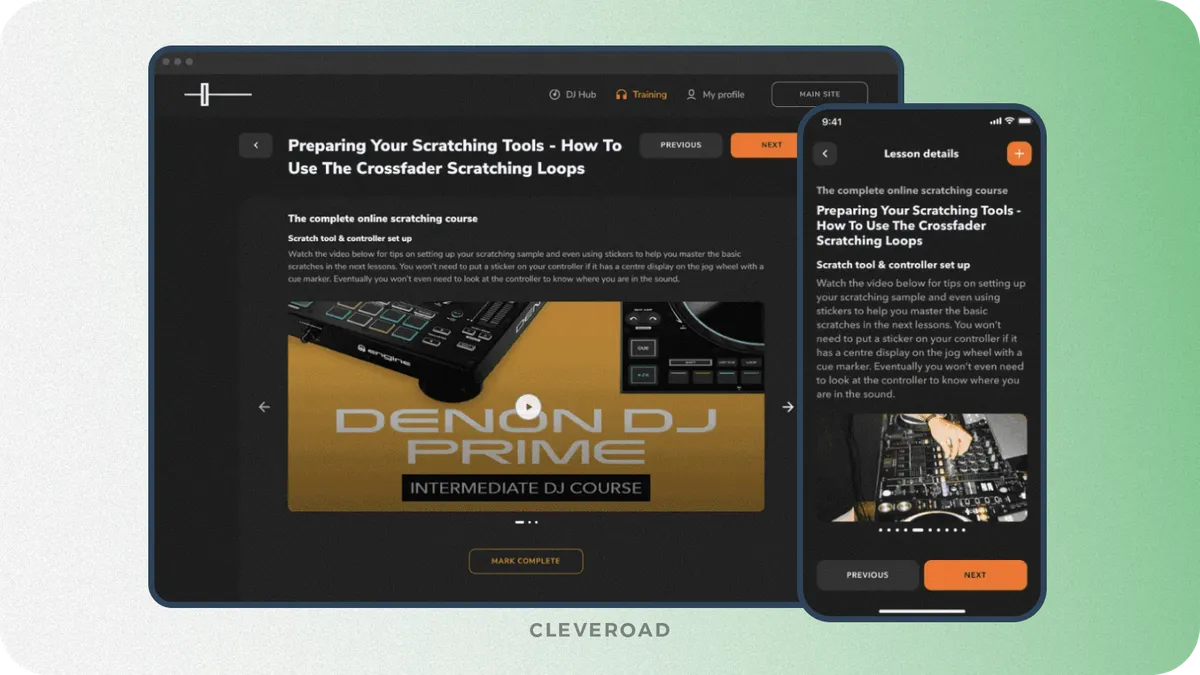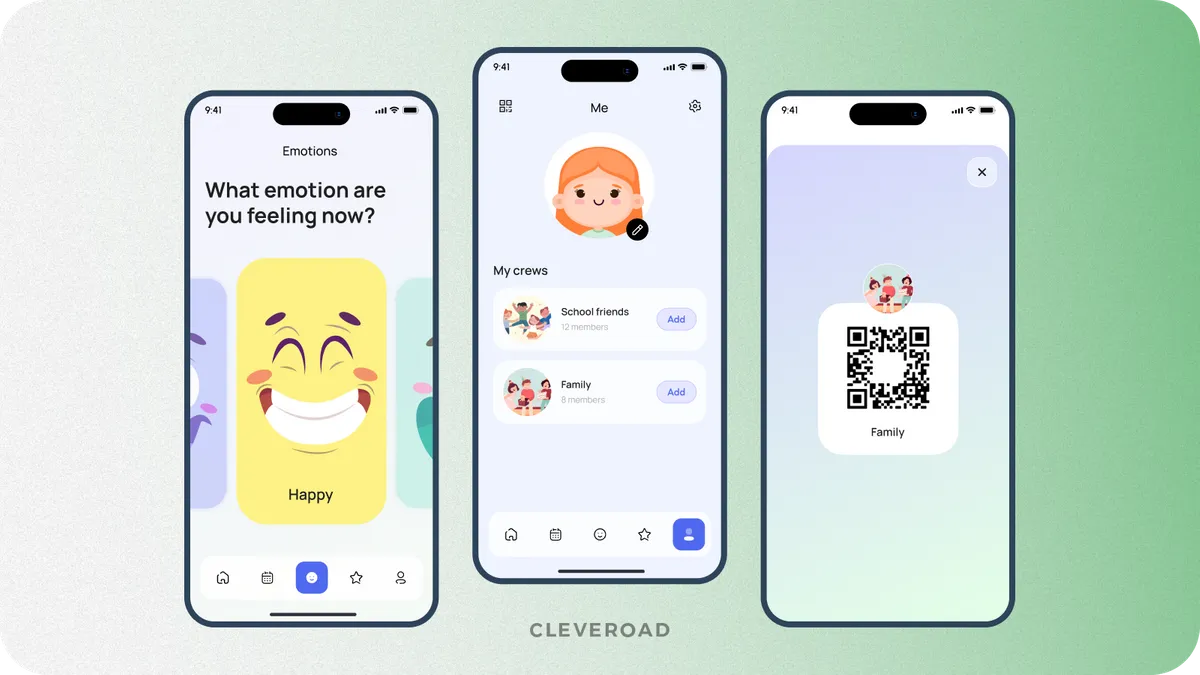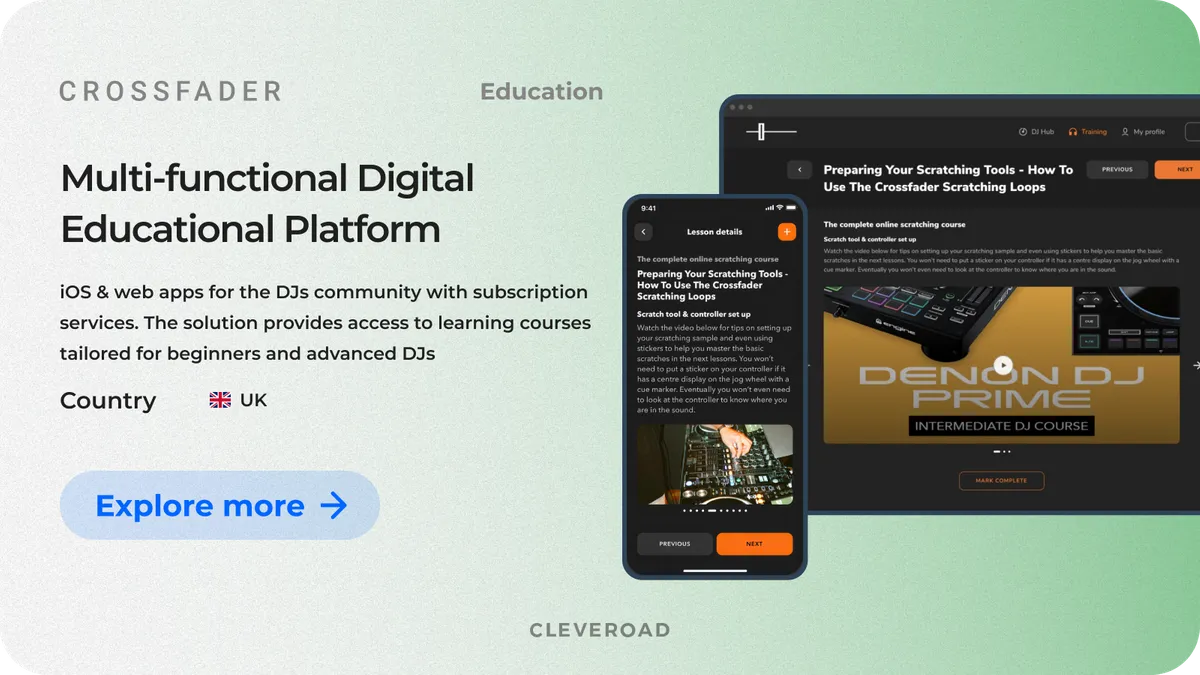How to Build a Learning Management System: Step-by-Step Roadmap
Updated 01 Aug 2025
19 Min
2871 Views
“How to create a Learning Management System (LMS)? Why do I need one? What should it do within my business ecosystem?”
If you ask these questions, then you are thinking in the right direction, because a well-designed custom LMS can streamline employee onboarding and upskilling, ultimately reducing both time and long-term training costs.
At Cleveroad, we develop Learning Management Systems for various domains, including education, healthcare, finance, and others. Our team is well-versed in all the nuances of LMS development, and in this guide, we’ll walk you through the main types of this software, how to build an LMS and integrate it into your business operations, as well as how to estimate its costs and potential return on investment.
Key takeaways:
- LMS platforms are widely used across industries to support employees onboarding, skills development, and performance monitoring.
- A tailored LMS should align with your organization’s training objectives, user structure, and scalability requirements from the outset.
- Starting with a Minimum Viable Product (MVP) enables faster delivery, early user feedback, and more efficient budget allocation.
- Gamification elements help improve learner engagement and motivation, especially in long-term or repetitive training scenarios.
What Is LMS and Who Needs It?
Before we start discovering how to create your own learning management system, it is worth delving into the basics and understanding what exactly an LMS is.
Learning Management System (LMS) is software that allows educators to create, share, and manage various training courses and programs, and automates the continuous learning process. To provide this functionality, LMS includes various tools that simplify the creation of learning content such as scripts, presentations, audio, and video materials, as well as establish the effective learning process through thorough pacing, various assessments, grading systems, and much more.
Core business roles within LMS
Learning Management Systems (LMS) typically involve several key business roles, and each of them performs specific tasks and demands its functionality.
- Learner. Learners can access courses, materials, and assignments, participate in learning activities, take tests, and track their progress throughout the learning process.
- Trainer. Trainers are responsible for creating and managing courses, adding materials and assignments, and providing them with feedback and support as needed.
- Administrator. Administrators oversee user management, define roles and access rights, create and manage courses, generate reports and analytics.
- Content creators. They develop educational materials, including lectures, videos, tests, and other learning resources, with a focus on maintaining relevance and quality.
- Learner support. This role assists learners by addressing tech issues, responding to inquiries about courses and materials, and offering support to facilitate effective learning.
How LMS Can Be Applied Within Different Business Domains
LMS software development has a huge impact on various industries. To illustrate their impact and how you can leverage them, we’ll explore real-world business scenarios where LMS software development has been successfully applied.
Healthcare
Children’s Healthcare of Atlanta partnered with CD2 Learning to implement a robust LMS designed specifically for healthcare professionals. The LMS delivers interactive leadership, clinical skills, and compliance training modules accessible 24/7 to accommodate shift workers. It incorporates gamified simulations to engage users and provide hands-on practice with clinical scenarios. The platform supports progress tracking, certification management, and automated reminders, ensuring all staff maintain up-to-date credentials and comply with healthcare regulations.
The system enhanced training consistency across multiple facilities, reducing administrative burden while improving patient safety and care quality. The flexibility of the platform enabled staff to complete training on their schedule, leading to higher course completion rates and improved knowledge retention. This solution allowed the organization to meet strict accreditation standards efficiently.
Logistics
DHL implemented a customized learning management system to train and certify its global workforce on safety protocols, compliance standards, and new operational procedures. The LMS supports on-demand training modules, interactive simulations, and performance tracking to ensure employees stay up-to-date with the rapidly evolving logistics landscape. It also facilitates multilingual content delivery to accommodate DHL’s diverse, worldwide staff.
This LMS deployment enabled DHL to reduce training costs and improve knowledge retention across its global operations. The system’s analytics helped identify skill gaps and optimize training programs, leading to higher operational efficiency and compliance rates. By streamlining workforce education, DHL strengthened its ability to meet customer demands and adapt quickly to industry changes.
Education
The Howard County Public School System adopted LMS to support its transition to remote and hybrid learning models. The LMS integrates seamlessly with student information systems (SIS) and enables teachers to create and assign digital coursework, track student progress, and facilitate communication through forums and messaging. It supports multimedia content, quizzes, and collaborative projects, fostering student engagement in a virtual environment. The platform also offers tools for parental access and involvement, which is critical in K-12 education.
Canvas LMS helped HCPSS achieve near-universal adoption among students and educators, ensuring uninterrupted learning during school closures. The system provided valuable data on student performance and engagement, enabling educators to personalize instruction and intervene when necessary. It supported innovative programs such as dual enrollment with local colleges, expanding educational opportunities for high school students.
Types of Learning Management Systems
When you require a unique LMS solution and consider creating a learning management system, you have to choose one of several types. Each has its own distinctive characteristics and satisfies the different needs of customers, so pick the one that suits your corporate requirements.
Open-source LMS
Open-source LMSs are software products with open-source code that are freely available to all users. They allow users to adapt and customize the system to their needs and requirements. Due to their open-source nature, these systems are highly customizable, enabling users to modify the code according to their specific needs. This flexibility makes them popular among institutions and organizations seeking tailored solutions without vendor lock-in.
Examples:
- Moodle
- Canvas (Open LMS)
- Chamilo
Commercial LMS
Commercial LMSs are mostly provided on a license or subscription basis. They usually offer a wide range of features, services, and support from professional teams. Commercial LMSs often have extensive customer support and regular updates, ensuring smooth operation and feature enhancements. While they typically require a subscription or license fee, the investment can be worthwhile for businesses requiring advanced functionalities and reliable support.
Examples:
- Blackboard Learn
- Adobe Captivate Prime
- Docebo
On-premise LMS
On-premise LMSs are installed and maintained on the client organization's servers, allowing full control of the LMS infrastructure and data and information security. These systems provide complete control over the infrastructure and data, making them suitable for organizations with strict security and compliance requirements, for example, for LMS for healthcare. While they may require higher upfront costs for hardware and maintenance, they offer long-term cost savings and customization options.
Examples:
- Blackboard Learn (self-hosted version)
- SAP Litmos
- Adobe Connect
SaaS LMS
SaaS LMSs are cloud-based software available over the Internet. They offer flexibility in deployment and upgrades and ease of use without the need to manage your own infrastructure. SaaS-based approaches: to LMSs offer scalability and accessibility, making them suitable for organizations of all sizes. With automatic updates and maintenance handled by the provider, users can focus on learning rather than IT infrastructure management.
Examples:
- TalentLMS
- Schoology
- LearnUpon
Integrated LMS
Integrated LMSs can be connected with other enterprise systems, such as Enterprise Resource Management (ERP) and Customer Relationship Management (CRM) systems. Integrations provide more flexible and efficient learning management. By seamlessly connecting with other systems, integrated LMSs streamline workflows and enable data sharing and automation, enhancing efficiency and user experience across multiple business functions.
Examples:
- Canvas (integrated with Google Apps for Education)
- Schoology (integrated with Microsoft Teams)
- Moodle (integrated with BigBlueButton for virtual classrooms)
Non-integrated LMS
Non-integrated LMSs operate independently of other enterprise systems and usually do not interact with them. They provide all the necessary features for learning management but can’t be connected with other applications. While they may lack some of the advanced functionalities of integrated solutions, they are often more straightforward to implement and maintain.
Examples:
- Docebo
- TalentLMS
- SAP Litmos
We provide robust education development services to help your business facilitate high-quality staff education
How to Build an LMS from Scratch: Steps to Consider
Building a learning management system is a multistep process, including several critical stages. Let’s review a brief step-by-step guide explaining how to create an LMS from scratch.
Step 1. Validate your LMS idea and target audience
Before diving straight into the development, take time to validate your idea and target audience. Start by identifying core user segments (e.g., corporate HR teams, universities, or training agencies, etc.), and dive deep into their pain points with current systems. Analyze competitors and assess what functionality users expect in a modern LMS.
Here is a step-by-step idea validation plan for successful LMS idea:
- Start by brainstorming the core idea behind your LMS: what problem does it solve, and how will it help your target audience?
- Conduct surveys to understand customer pain points and desires. Knowing what users love and hate about existing LMS platforms is invaluable.
- Analyze negative reviews of competitors for honest feedback. Unhappy customers often reveal insights that can guide product improvement.
- Break down your business plan, focusing on customer needs rather than internal requirements. Planning will help with budgeting and product development.
- Choose an LMS type and decide on a business model that distinguishes you from competitors and underlines your unique value proposition.
We at Cleveroad offer a free Solution Design Workshop aimed at helping you turn your raw idea into a detailed LMS tech realization plan. We will help you map user personas, define feature priorities, and translate business needs into technical specs, all in under two weeks.
Step 2. Choose a skilled and trustworthy LMS development partner
A proper LMS platform development requires deep experience to adequately implement all the necessary features for a flawless user experience. You can choose to outsource your product to an experienced education app development company to collaborate with. For example, we at Cleveroad will consult you on any technical issues you may encounter and carefully guide you through the software development process, from idea validation to development and support.
We facilitate the following models of cooperation during LMS development:
- Dedicated development team. The outsourcing vendor provides a whole LMS development team, controls all the steps, and provides quality results.
- Staff augmentation. Your IT partner provides the required expenses to expand your in-house team's capabilities. Developers join your team remotely to accomplish specific LMS project tasks.
Step 3. Start LMS development from MVP
Instead of going all-in, first focus on a lean version of your LMS. A Minimum Viable Product is a stripped-down version of your platform that includes only the core functionalities necessary to solve the key problem for your users. Starting with an MVP helps you reduce initial costs, validate your product-market fit, and gather valuable feedback before scaling. It’s especially beneficial when you’re looking to build LMS from scratch, as it allows for agile adjustments based on real-world usage.
A typical MVP should include features such as:
- Course management (create, update, assign, and manage learning content)
- Role-based access control (admin, instructor, learner permissions)
- Basic analytics and progress tracking
This iterative strategy significantly shortens the time to market and prevents investing in features that might not bring user value.
Get to know more about how the MVP development services we provide at Cleveroad can help you launch an LMS in a swift and cost-effective way
Step 4. Design user-centered LMS UI/UX
When developing a learning management system, you should have a well-thought-out design since half of the user experience depends on it. Therefore, the LMS should be visually appealing, easy to use, and provide a brand identity. Moreover, you should create an LMS that will look flawless on all existing devices. Responsive design, which implies automatic adaptation to any device, is critical for such solutions. A professional software vendor with quality UI/UX design services will consider all these details and help you create the perfect learning management system.

LMS system UI/UX designed by Cleveroad
Step 5. Develop and test your LMS
After all preparations are complete, your IT partner starts learning the management system development process. During this stage, UI/UX designers work on screen mockups for the future LMS, which they then transfer to the development team. Developers use their technical expertise to turn layouts and features of the learning management system into a working product.
We at Cleveroad adhere to Agile SDLC, which implies that the development of learning management systems will consist of sprints. During each sprint, which mostly lasts two weeks, developers implement a certain part of the LMS functionality. QA engineers also actively participate in the development process, conducting various tests to ensure the learning management app is stable.
Step 6. Release sequence and marketing campaign
After developers finish creating a learning management system and QA engineers ensure it works correctly, it is time for release. Specialists will move your LMS to the live server if it is a web solution or launch it in the app stores for a mobile one. However, do not expect millions of students worldwide to start using your educational product immediately after the system is deployed. You should launch a marketing campaign that will allow you to inform potential users about your LMS.
What Features to Include Within Your LMS?
To help you successfully accomplish LMS software development, we have highlighted several must-have features of learning management systems that should be implemented for a smooth studying experience:
Course management
The course management feature is the basis for creating an LMS. It allows admins and teachers to upload new courses or modify existing ones (e.g., change tags and descriptions, hide or add ready-made courses to the list, etc.)
A convenient editor is critical for good learning course management to allow educators to create a course of any format and any complexity from scratch. Effective learning management system development requires implementing tools that allow working with text, images, audio, and video files. If you're wondering how to build LMS platforms that are scalable and flexible, this module should be your starting point.
User and group management
Developing a learning management system with user and group management is vital for building a clockwork learning process. It allows teachers to organize students into groups, assign assignments to entire groups or individual students, send private messages and notifications to students, and much more. Thus, interaction with the learning platform will become complete and convenient for all participants in the educational process.
Gamification
Classic online learning can be boring, especially if you develop an LMS targeting a younger audience. Gamification solves this problem and makes the learning process more interactive and fun. For example, you can create a simulated transition to the next level, introduce a system of prizes for the successful completion of tasks, and so on. Thus, an LMS with a gamification feature will significantly increase user engagement and satisfaction.
By the way, we recently developed a solution with engaging gamification functionality – Health Habit Tracking System. In this app, gamification includes streaks, reward systems, animations with custom characters demonstrating exercises, emotional tracking that adapts activities based on mood, and team-based competition via virtual “crews” where users connect through QR codes and track progress together. Features like these can boost engagement when you create your own LMS.

Gamification feature within LMS solution designed by Cleveroad
User roles and permissions
User roles and permissions allow editors to customize access to specific course units, information, and functionality to ensure data security, providing high user trust in your platform. Moreover, Role-Based Access (RBAC) will allow you to successfully adhere to the requirements of security standards and education domain regulations such as GDPR in the European Union and FERPA in the United States. Consider this functionality if you're planning to create your own LMS aligned with regulatory needs and structured access.
Knowledge testing
Testing is the most important stage of training, as it allows you to find out how the students learned the new educational material. This module should have the tools to create various assessments, ranging from simple tests with one answer to multi-answer quizzes and tasks requiring a detailed answer. Besides, it is worth it to build your own learning management system with tools for setting deadlines and time limits for a particular test to ensure organized knowledge checks.
Reminders and announcements
These features are the basic way of communicating with the course students. Through notifications, you can inform students about uploading new course material, assigning tasks, the nearest deadlines, and invite them to check the test results. Integrating such communication tools is a smart move that keeps learners engaged and up-to-date.
Reporting and analytics
Detailed analytics allows you to find out the results of training and its success. This LMS feature is represented by a learner progress journal and a teacher report. In addition to providing superficial data such as final grades and credit counts, analytics can provide vital data for course improvement. Keep track of which assignments are taking too long for students, the overall results in specific topics, and much more. Analyze the situation to understand what aspects of the course can be improved. It’s an essential component if you're planning to build an LMS from scratch that delivers value based on performance metrics.
Cleveroad Expertise in Creating Custom eLearning Solutions
To demonstrate our experience in educational software development, we will present a couple of our latest EdTech cases – an Online education platform for DJs and a Healthcare LMS.
Healthcare LMS
A US-based client providing online educational and training programs for medical students partnered with Cleveroad to replace an outdated and inflexible WordPress-based solution. The primary goal was to create a modern healthcare learning management system tailored for healthcare education, with a centralized system for managing training content and delivering a streamlined user experience across web and mobile platforms.
To meet this goal, Cleveroad developed a custom healthcare LMS that offers tiered learning materials based on student levels, supports subscriptions for continuous professional education, and enables responsive access from any device. The project included full-cycle product development, from business analysis and UI/UX design to IT consulting and feature implementation, along with regular feedback loops from focus groups to fine-tune the platform.
As a result, the customer now operates a robust, scalable healthcare LMS that aligns with business objectives. It enables continuous training for medical staff, supports preparation for official certifications, and has become a reliable tool in the client’s growth and monetization strategy.
Creative learning platform for DJs
A UK-based company behind the fast-growing DJ training platform “We Are Crossfader” sought to expand its value offering by building a more flexible and feature-rich multi-functional digital educational platform for DJs. The goal was to enhance the learning experience, introduce a subscription-based DJ Hub, and move away from the limitations of the existing WordPress platform, while retaining its growing global user base.
Cleveroad developed a comprehensive digital learning environment that includes a fully functional DJ Hub with monthly and annual subscription options. A new admin panel was built to simplify content updates, while the system ensured seamless migration of existing users and their previously purchased courses. In addition, the team delivered an iOS application with offline learning capabilities, expanding user access and platform usability.
As a result, the customer received a dynamic and monetizable LMS that supports learners. The platform offers flexible access across web and mobile, enables fast content updates, and has successfully shifted to a modern tech stack that ensures scalability and improved user experience.
Here’s what Jamie Hartley, CEO & Founder at Crossfader says about cooperation with Cleveroad
Jamie Hartley, CEO & Founder at Crossfader provides feedback about cooperation with Cleveroad
What Is the Price of Creating Your Own LMS
The pricing of a learning management system depends on many factors, such as project scope, feature complexity, third-party integrations, etc. On average, the cost of custom LMS development typically ranges from $70,000 to $160,000, depending on the feature set, tech stack, and complexity.
The main aspect is the time developers spend building your learning management system. Let's see how long it takes and how much it may cost to build Learning Management System from scratch, including only the basic system functionality:
| Core LMS features | Approx dev time (hours) | Estimated cost ($) |
User and group management | 120-140 h | $6,000-$7,000 |
Course management | 500-550 h | $25,000-$27,500 |
Reporting and analytics | 280-320 h | $14,000-$16,000 |
Gamification | 200-240 h | $10,000-$12,000 |
Testing and assessment | 160-180 h | $8,000-$9,000 |
Reminders and announcements | 50-60 h | $2,500-$3,000 |
User roles and permissions | 100-120 h | $5,000-$6,000 |
Total | 1,410-1,610 h | $70,500-$80,500 |
Please note: These calculations are approximate and based on the basic functionality of the learning management system. The LMS costs also include expenses for the time of other experts, such as Project Managers, UI/UX designers, QA engineers, DevOps, etc. These expenses are calculated separately and depend on the required skills and experience of each specialist. Order an estimate to receive more clarity on how much an LMS will cost within your specific business case.
How much can you save with a custom LMS?
The decision to build an LMS platform may also bring you a pleasant hidden benefit – a significant cost reduction. Below, you’ll find some interesting stats that highlight such LMS impact:
- Deloitte and Continu state that LMS-based training accelerates onboarding and learning, with enterprises saving 40-60% in training delivery costs and recovering hundreds of hours annually across teams. One case study shows $150 per-employee/year in savings, culminating in $750K annually for a 5,000-employee company.
- LinkedIn claims that high-performing companies report up to 57% higher retention and a 1.3× improvement in training-driven cost reductions. Compliance tracking, certification logs, and reduced audit risks add quantifiable value.
- According to Illumeo Financial Services Organization, training costs drop by 42%, onboarding time by 30%, and compliance errors are reduced by 50% after deploying an LMS.
We interviewed our clients for whom we developed LMS solutions to understand the impact on their business processes. They reported significant operational and financial improvements after implementation and shared tangible results with us.
| Category | Without LMS | With LMS | Estimated savings |
Training and logistics | ~$100K annually | ~$40K (e‑learning replacement) | ~$40K–$60K |
Onboarding and admin overhead | ~$80K (manual forms) | ~$35K (automated onboarding) | ~$30K–$40K |
Productivity and engagement gains | Baseline value | 1-3% performance improvement | Equivalent to +$20K–$60K |
Compliance/admin risk handling | Manual tracking | Automated certification | Reduced audit costs/risk fines |
Why Choose Cleveroad as an LMS Development Partner?
Cleveroad is an education software development company from the Central and Eastern Europe (CEE) region. Since 2011, our team has provided Education app development services to enhance the learning experience for students, teachers, educational institutions, and small, medium, and large-scale businesses. We specialize in crafting diverse educational software solutions, including Learning Management Systems (LMS), student information systems, e-learning portals, virtual classrooms, content management systems, proctoring systems, and more.
By choosing Cleveroad for LMS development, you will get the following benefits:
- Tailored LMS and EdTech development services addressing your unique goals, ranging from custom LMSs and legacy modernization to 3rd-party integration and full process digitization.
- Proven experience in LMS integrations with platforms like Adobe Captivate Prime, Canvas, Moodle, SAP Litmos, and more, ensuring seamless ecosystem connectivity and data consistency.
- Tech proficiency aligned with compliance, we build LMSs in line with SCORM, xAPI, LTI, AICC, GDPR, HIPAA, CCPA, WCAG, and Section 508 requirements.
- Free Solution Workshop to align goals, we connect your business strategy with LMS functionality, mapping out priorities, risks, and value-driven features before development begins.
- Flexible engagement models, choose the Dedicated Team or Staff Augmentation approaches to match your development pace, budget, and internal capabilities.
Build a custom LMS with domain experts
Contact us, our developers with 13+ years of experience in educational software creation are ready to build or modernize your learning management system to match your corporate training goals
LMS development is the process of designing, building, and deploying a learning management system software, a solution that supports structured learning through tools such as dashboards, training management modules, and progress tracking. A custom learning management system development project typically begins when businesses understand the purpose of eLearning and need to improve their employee training, talent management, or corporate learning workflows. The system involves collaboration between a web development team, business analyst, and designers to build an LMS system that aligns with your business goals.
To develop a learning management system from the ground up, the process starts with a project plan that maps out features, timelines, and budget. During the design phase, a design system and UX strategy are created, including design elements that support mobile learning and social learning experiences. After this, a web development and custom software development team implements modules like course creation, communication tools, and LMS backend architecture. Best LMS practices suggest that including progress tracking, certifications, and personalization features will make learning more effective. Once your feature-rich LMS is tested and deployed, you can compare it to an installed LMS or ready-made LMS and observe benefits like increased engagement and cost savings in the long run.
Costs vary, but a custom LMS development project typically ranges between $80,000 and $250,000. Factors influencing price include whether it’s a web-based LMS, the complexity of the product design, scalability of the LMS backend, and any integrations required for distance learning or training management. If your LMS implementation project plan includes advanced features to support overall learning efficiency, such as a robust dashboard, analytics, or gamification, expect the price to be higher. Compared to a simple LMS, building a feature-rich LMS tailored to your goals ensures the LMS plays a strategic role in long-term corporate learning outcomes.
Creating a learning management system’s architecture starts by aligning with your business goals and analyzing how an LMS to ensure smooth educational delivery can serve your audience. During the design phase, the product design incorporates responsive layouts for mobile learning and collaborative features for social learning. Development then moves to the LMS backend, where key components such as course management, assessments, and user tracking are built by a web development team using custom software development practices. Whether you're transitioning from a ready-made LMS, upgrading an installed LMS, or creating something entirely new, a well-planned project plan ensures your LMS already meets future scaling needs, aligns with global LMS market trends, and ultimately helps make learning more impactful.

Evgeniy Altynpara is a CTO and member of the Forbes Councils’ community of tech professionals. He is an expert in software development and technological entrepreneurship and has 10+years of experience in digital transformation consulting in Healthcare, FinTech, Supply Chain and Logistics
Give us your impressions about this article
Give us your impressions about this article
Comments
1 commentsHi, Thanks for sharing the detailed article on building LMS from the scratch. Could you please share some more details on which software development tools or coding languages are used to support the architecture of an LMS.


